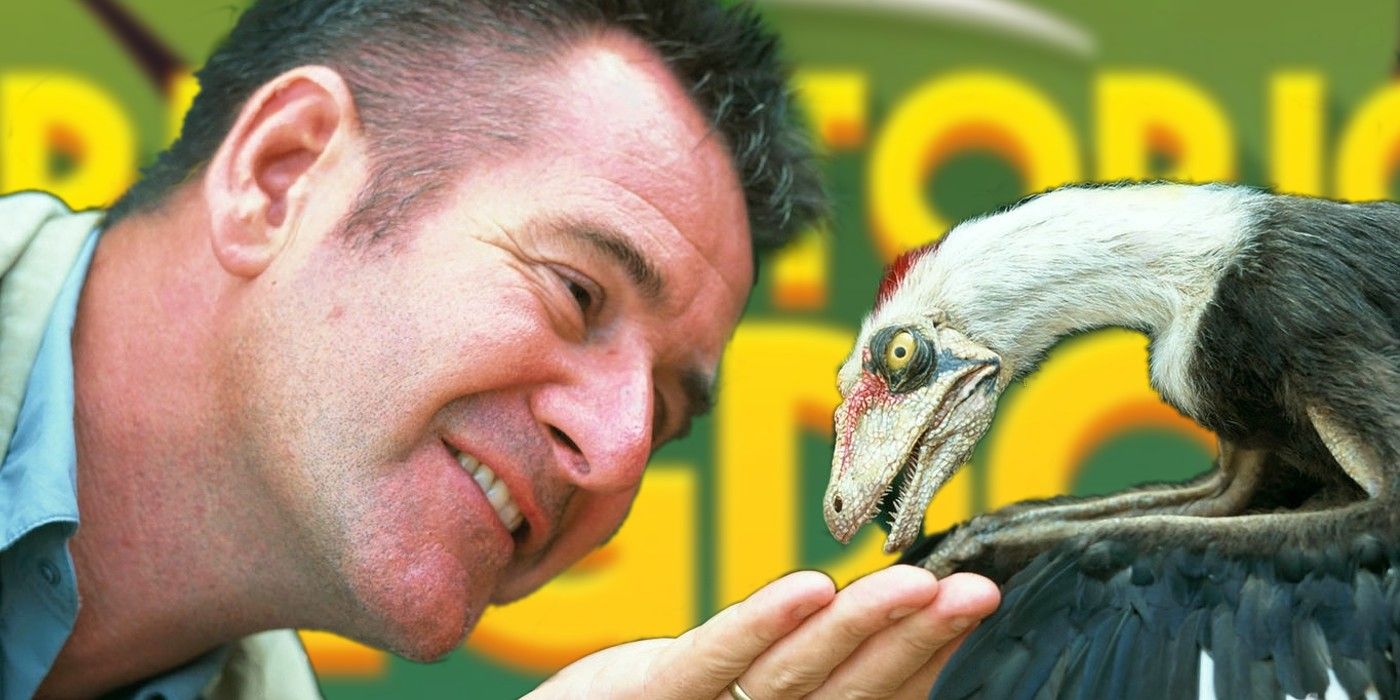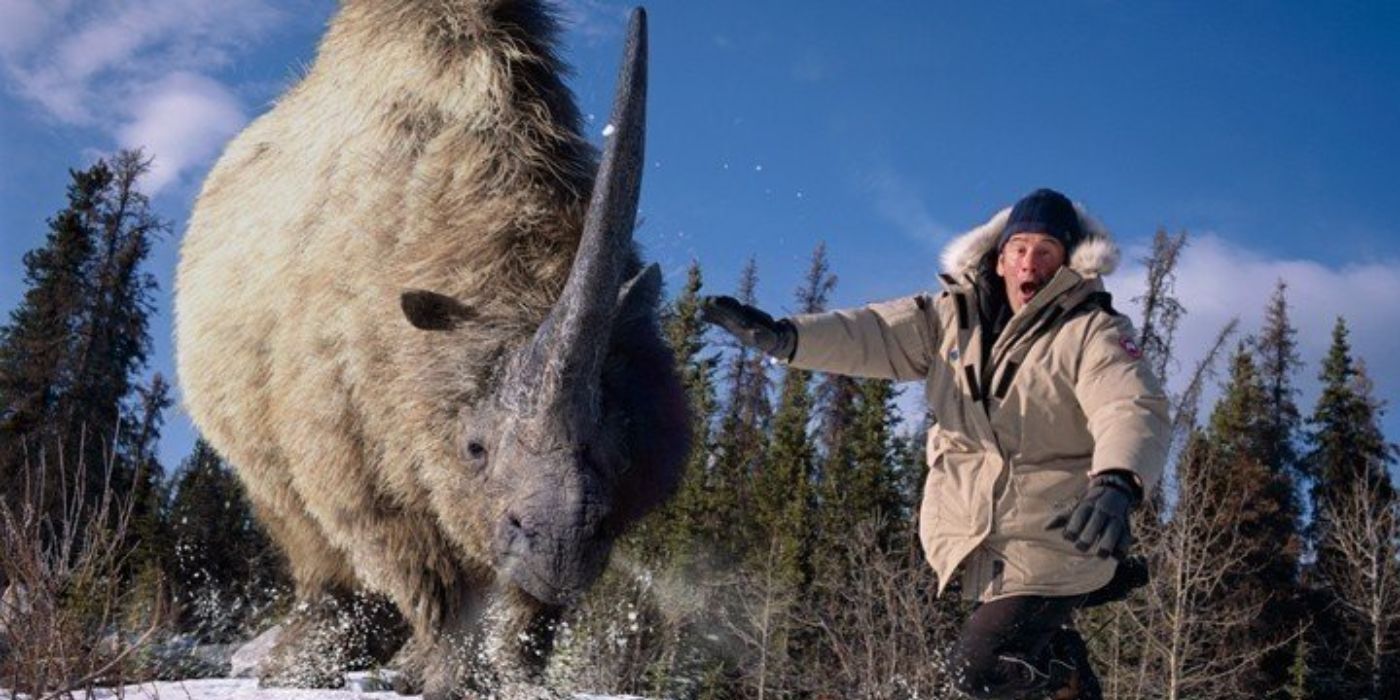
What next?” Rather than focusing on reviving extinct species, it delved into the implications of making such a decision, its challenges, and more pressing issues confronting our natural world.
First published in 1990, Michael Crichton’s “Jurassic Park” delved into the potential consequences if dinosaurs could be re-created using fossilized DNA and genetic engineering. It vividly portrayed the complexities and chilling implications of such a scenario. Subsequently, filmmaker Steven Spielberg brought it to life on the big screen in 1993, earning recognition as one of NASA’s most authentic sci-fi tales. The book was an enormous hit, spawning a massive franchise that includes films, TV shows, and countless other spin-offs. Even three decades later, “Jurassic Park” leaves us questioning whether such a reality might someday be possible.
A Look Back at Animal Planet’s Prehistoric Park
Time Travel, T. Rexes, and Nigel Marven
In the past, before “Jurassic World: Camp Cretaceous” and “Jurassic World: Chaos Theory”, Animal Planet and UK network ITV teamed up to revive television appearances for British naturalist Nigel Marven. He gained notoriety for a unique skill: dodging computer-generated dinosaurs on screen. Often compared to a blend of Animal Planet’s “The Crocodile Hunter” and another show, Marven rose to fame through the “Chased By…” series. This time, instead of just studying extinct creatures, he would be responsible for their care in the 2006 production, “Prehistoric Park”.
In this mockumentary, Nigel Marven presents an intriguing thought to the viewers: “Could extinction not be permanent?” Similar to Jurassic Park, Marven aims to construct a contemporary zoo of prehistoric creatures he believes deserve a second opportunity. However, unlike the theme park or luxury island resort on Isla Nublar, Marven is developing a wildlife refuge – a place where the last remaining species can be fully valued, looked after, and perhaps inspire visitors to recognize that these animals were far more than mere museum exhibits or screen monsters; they were real creatures.
Unlike the creatures in “Jurassic Park,” which were theoretically cloned from dinosaur DNA or like the genetically engineered gray wolves by Colossal Biosciences, called “dire wolves,” Marven’s approach deviates from these methods. Instead of relying on genetic manipulation or cloning, he employs a classic science fiction concept: time travel. Similar to how he sends expeditions to significant mass extinction sites, Marven doesn’t hunt extinct animals; instead, he retrieves live dinosaurs, enormous insects, and various other extraordinary species that were the “last of their kind” in their respective eras, allowing them to continue living in the present day.
Within the confines of the park, “Prehistoric Park” ventures into an area seldom explored by most Jurassic Park films. Much like reality shows centered around zoos, “Prehistoric Park” delves into the struggles of rearing these ancient creatures in today’s environment and the knowledge vets would require. From a Triceratops acting aggressively during mating season to a solitary mammoth yearning for a herd, or even attempting to hatch a clutch of Ornithomimus eggs, the team at “Prehistoric Park” was consistently faced with challenges, striving to care for and comprehend creatures known primarily through their fossils and modern relatives.
By combining science and narrative, thrill and education, “Prehistoric Park” offered viewers a more authentic version of “Jurassic Park,” delving into the true-to-life sciences of paleontology and conservation. Despite airing just six episodes, “Prehistoric Park” has earned a dedicated fanbase, often referred to as a heartfelt spin-off of “Jurassic Park.” Its enduring legacy continues, even as Marven focuses on other parts of the world and the living creatures he remains passionate about.
Animal Planet’s Dinosaur Docuseries Addresses Modern Concerns
Prehistoric Park Remains Relevant in Real Life





The movie “Jurassic Park,” although it was made in the ’90s and its depiction of dinosaurs reflects that era, still carries a timeless quality. A contemporary retelling of Frankenstein’s tale, where humanity dabbles with resurrecting the dead, continues to be a cinematic classic. However, as scientific advancements bring us closer to actual de-extinction technologies, “Prehistoric Park” seems more pertinent than ever before.
The idea of bringing extinct creatures back to life, or de-extinction, is not a recent development, but was significantly boosted in popularity by the depiction in “Jurassic Park”. Michael Crichton’s blend of speculative science and cinematic magic made the concept seem plausible for audiences captivated by the realistic dinosaurs in the movie. Though scientists have long pondered if dinosaurs could ever be cloned, there have been actual endeavors aimed at resurrecting both extinct and critically endangered species.
2009 saw the brief cloning of an extinct species, the Pyrenean ibex, which unfortunately passed away soon after birth. Simultaneously, researchers have been able to cultivate extinct plants from seeds that are a thousand years old. Furthermore, genetic studies have resulted in chickens displaying traits similar to dinosaurs by stimulating specific genes. Lately, the authenticity of Colossal Biosciences’ so-called “dire wolves” remains questionable; however, their work mirrors the concept presented in Jurassic Park – the revival of animals from past eras using contemporary DNA technology.
In considering whether prehistoric creatures like the mammoth, sabertooth, dodo bird, or many others could be cloned or engineered, two significant questions arise: “What implications would this have for these animals?” and “Are we ready as a society to welcome them back?” The series Prehistoric Park doesn’t skirt these ideas. Instead, it underscores that reviving a creature is just the start; managing their survival, safety, and well-being in a world that has progressed becomes the far more complex challenge.
In contrast to Jurassic Park, which frequently portrays its creatures as scientific experiments or movie monsters, Prehistoric Park truly shines by emphasizing conservation. As a genuine wildlife presenter and animal advocate, Nigel Marven imbues the show with sincerity about the belief that extinct animals merit more than mere spectacle; they deserve care and preservation. His intention is not merely to amuse viewers but to offer these organisms a second life, treating them as living beings with requirements, instincts, and a claim to existence. This subtle yet impactful perspective change mirrors the real-world challenges faced by scientists and conservationists in relation to de-extinction and the potential reality of a place like Jurassic Park.
The Legacy of Prehistoric Park Lives On
Prehistoric Park Isn’t Extinct Quite Yet
Could it be possible that Prehistoric Park, much like the multitude of creatures Nigel saved on the show and the animals humanity is attempting to revive, may make a comeback? Given its status as a cult favorite and the continued relevance it holds due to ongoing scientific breakthroughs, Prehistoric Park appears primed for a reboot or continuation. The chance has presented itself, the groundwork has been laid, and with both the Jurassic World films and Walking With Dinosaurs announcing their grand return in 2025, enthusiasts are optimistic that this cherished series might join them.
Despite persistent community backing and a surge of interest, Animal Planet and the team behind “Prehistoric Park” have been tight-lipped about any revival plans. Yet, a spiritual successor unexpectedly emerged in the form of the video game “Prehistoric Kingdom”. Noted personality Nigel Marven was even roped in to narrate the trailer and tutorial, allowing fans an opportunity to create their own dinosaur haven, complete with the struggles and thrills that come along. It might not be “Prehistoric Park” Season 2, but it maintains the essence of its spirit, curiosity, and adventurous nature, merely in a new format.
In our journey of replicating Earth’s past and moving towards the future, it’s crucial to never lose sight of the here and now. Series like Jurassic Park and Prehistoric Park serve as poignant reminders that the animals they depict are not just fictional, but have actually walked on this planet. Extinction is a harsh reality, and though we may dream about witnessing a real T. Rex, perhaps we can instead take time to admire and aid conservation initiatives led by individuals such as Nigel Marven. Conservation, after all, could be the key to ensuring that these incredible creatures continue to exist. Sometimes, preventing extinction is as straightforward as lending our ears to those who are still striving to make their voices heard.
Read More
- 50 Goal Sound ID Codes for Blue Lock Rivals
- Quarantine Zone: The Last Check Beginner’s Guide
- 50 Ankle Break & Score Sound ID Codes for Basketball Zero
- Ultimate Myth Idle RPG Tier List & Reroll Guide
- Lucky Offense Tier List & Reroll Guide
- Mirren Star Legends Tier List [Global Release] (May 2025)
- Every House Available In Tainted Grail: The Fall Of Avalon
- How to use a Modifier in Wuthering Waves
- Basketball Zero Boombox & Music ID Codes – Roblox
- Enshrouded Hemotoxin Crisis: How to Disable the Curse and Save Your Sanity!
2025-04-18 02:23